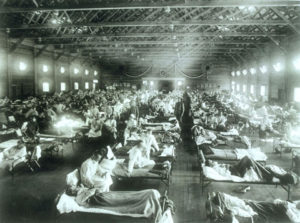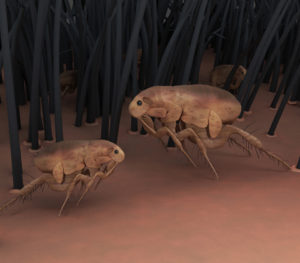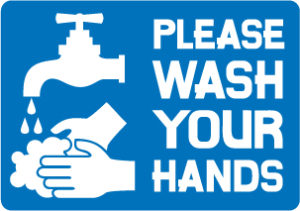
Less than 100 years ago, 50 million people died from an influenza pandemic. Since then, the planet has become only more crowded as some areas of medicine run out of treatment options, creating conditions suitable for another global outbreak.
Here are five pandemics that could wipe out humanity in the near future, along with my own unscientific odds of it actually happening and a prep tip to keep you grounded.
Pandemic #1: The Return of the Spanish Flu

Although the trendy term for a TEOTWAWKI health event today is “pandemic,” the worst and most recent such outbreak in modern history was labeled under the deceivingly mundane “flu” name: The Spanish Flu. It was so devastating it practically ended World War I in 1918 all by itself.
Although the Spanish Flu actually originated somewhere else in World War I Europe, neutral Spain got stuck with the name likely because of the Allies' and Central Powers' propaganda machines containing information along the Western front.
Regardless of where it started, around 50 million people worldwide would later die from the Spanish Flu. Many of them had only hours to live after first noticing the symptoms. Thankfully, it burned itself out by the end of 1919, exiting the stage just in time for the 20th Century “good ol' days” of the Great Depression, another world war and the start of a decades-long Cold War. Yep, the Spanish Flu is a thing of the past.
Or is it?
Diseases adapt to their environments. The fast-killing strains had to go away because they ran out of hosts. The slower moving ones mutated into what became today's worst flu strains. (P.S. Go read Guns, Germs and Steel by Jared Diamond for a fascinating history lesson on how diseases shaped humanity.)
Remember swine flu from a few years back? And bird flu in the mid-2000s? Those were all distant relatives of the Spanish Flu. From ABC News comes this Spanish Flu news:
Health experts are concerned that the Spanish flu that ravaged the world has many similarities to the avian flu now found throughout Southeast Asia.
The 1918 flu strain itself originated as an avian flu that mutated into a form that could jump between humans. And the 1918 strain, according to research published this week in the scientific journals Nature and Science, has several of the same genetic mutations as the current avian flu strain.
Could a deadly pandemic happen again? Some doctors say yes.
On the plus side, maybe the Spanish won't get the shaft on naming rights this time around.
- SHTF Odds: 21%
- The Verdict: The Spanish Flu never went away, but thankfully its modern relatives are under close observation by health agencies.
- The Prep: The more self-sufficient you are, the less likely you are to go out into the great unwashed masses. Check out the Little House in the Suburbs book to get started.
Pandemic #2: Drug-Resistant Bacteria

Viruses like the Spanish Flu don't get to have all the fun. Bacteria want a piece of the action, too. In an ironic twist, the harder humanity tries to get rid of them, the stronger bacteria become.
Here's how that happens. A dose of antibiotics in sick humans, livestock or other animals wipes out harmful bacteria causing the illness. But a small number of bacteria survive because of some quirk in their genetics. Those bacteria reproduce and can spread to other hosts, living as long as a stronger antibiotic doesn't kill them.
When antibiotics are overused, you wind up with stronger bacteria. Some may even become resistant to any antibiotics. It's important to find a balance to prevent so-called “superbugs” from developing.
Not to worry, Dr. Uncle Sam is on the case. As this PBS article on drug-resistant bacteria highlights, Congress started the Interagency Task Force on Antimicrobial Resistance in 1999 to address the problem, with predictable results:
Part of the problem is that there’s been very little attention at the highest levels of government to antibiotic resistance. Although Congress created an Interagency Task Force on Antimicrobial Resistance in 1999, the committee hasn’t put together the “coordinated, national surveillance plan” its own action plan recommended in 2001. The task force has no dedicated staff and when we asked the CDC to tell us about it, we learned that the body has only met in person 11 times.
I guess that's where the phrase “death by committee” originated.
And that's not an article posted years ago. PBS ran that this week. There's not enough space here to get into why antibiotics are overused, but it's certainly a concern.
- SHTF Odds: 29%
- The Verdict: Until humanity can figure out how to find a balance with antibiotics, those odds are only going to go up. This is a scary one. Watch this PBS video report if you don't believe me.
- The Prep: Learn how to use a First Aid kit effectively, like this comprehensive Grizzly Adventure Medical Kit at the Living Ready Store. Quick treatment of injuries can prevent you needing antibiotics in the first place. Don't be part of the problem.
Pandemic #3: SARS/MERS

It's already been 10 years this month since the SARS (severe acute respiratory syndrome) outbreak infamously hit Toronto, Canada, after making its way from Asia. The outbreak ended in 2004 after claiming less than 1,000 lives worldwide, as the CDC (Centers for Disease Control and Prevention) reports on its SARS website.
So there's nothing to worry about right?
Not quite. Check out this disturbing bit from the CDC's SARS information page:
On October 5, 2012, the National Select Agent Registry Program published a final rule declaring SARS coronavirus a select agent.A select agent is a bacterium, virus or toxin that has the potential to pose a severe threat to public health and safety.
Well, anything could be a potential. I could potentially be hit by an elephant dropping out of the sky. That doesn't mean it's going to happen, right?
Actually, SARS is slowly crawling its way back into the spotlight. Reports out of Mecca in Saudi Arabia indicate a new type of SARS, called MERS (Middle East Respiratory Syndrome Coronavirus), is infecting religious pilgrims. A SARS report from The National in September lays it out:
Countries sending pilgrims to the Haj in Saudi Arabia should increase surveillance for a deadly virus that has killed more than 50 people in the kingdom, the World Health Organisation’s emergency committee has said.
While the committee said the Mers coronavirus outbreak is not yet a public health emergency, the Haj pilgrimage, which begins next month [October] and last year attracted 3 million pilgrims, has raised concerns that the virus could spread globally.
The concern here is having that many people in one spot with a relatively unknown virus on the loose. Cramped quarters in World War I led to the Spanish Flu. Could the Haj be ground zero for the same kind of outbreak?
- SHTF Odds: 12%
- The Verdict: The Haj ended earlier this month without much fanfare on the viral front. Still, MERS will and should be a concern for this annual Islamic pilgrimage. Time will tell, but officials are already screening pilgrims for MERS in and out of Mecca, a good sign that the lessons from the Spanish Flu are being heeded. However, pandemics love, love, love high concentrations of people in small areas.
- The Prep: Don't lose too much sleep over this one. Read a book instead with this bundle of survival guides and gear at the Living Ready Store. It includes two Creek Stewart survival books and some cool gear at a great discount.
Pandemic #4: The Bubonic Plague

Sensing a pattern yet? Diseases don't go away. They just change shape and lurk until the right moment.
The Bubonic Plague (aka, “The Black Death,” “The Plague” or – as I like to call it – “The Reason I Don't Feel Bad About Mouse Traps Disease”) is still around. Last year, 256 people in Madagascar died from the Plague. Rats are to blame, as they were in the 14th Century, for the outbreak. Or more specifically, the fleas that transmit the disease from rats to humans.
Not surprisingly, overcrowding is the spark for the latest Plague outbreak, this time in rat-infested prisons. Here's the latest on the Madagascar prison Plague from The Guardian:
Christoph Vogt, head of the ICRC delegation in Madagascar, said: “The chronic overcrowding and the unhygienic conditions in prisons can bring on new cases of the disease. That's dangerous not only for the inmates but also for the population in general.”
An average of 500 cases have been recorded on the island every year since 2009. October is the peak month as hot humid weather attracts fleas, which transmit the disease from rats and other animals to humans.
Containing the rats is critical. Because if the disease ever jumped the prison wall…
Christophe Rogier of the Pasteur Institute of Madagascar told the BBC: “If the plague gets into prisons there could be a sort of atomic explosion of plague within the town. The prison walls will never prevent the plague from getting out and invading the rest of the town.”
But Madagascar is an island. It's not like there are rodents running around the western United States carrying the Plague, and it's entirely possible that the disease could find a way to leap humans, right?
From NPR:
AUDIE CORNISH: For most of us, plague is something that maybe we read about in history books. In the 14th Century, it wiped out half of Europe's population. But the bacteria is busy killing wildlife now in the American West. By studying small mammals scientists have learned that plague is far more pervasive a killer than anyone thought.
BIGGINS: Plague would come from this unknown source and invade quickly into a prairie dog town, explode and kill almost all the prairie dogs, and then disappear back into its reservoir form where it existed without damaging anything too much.
And from the same article:
Plague is killing various kinds of mice and ground squirrels in New Mexico and Mexican wood rats in Colorado.
All it would take is a way for the Plague to get from these U.S. rodents to humans, and you'd have yourself a pandemic straight out of the 14th Century. It may already be happening. Last month, The New York Times reported that the U.S. is near the top of Plague countries:
The United States now ranks 11th in the world in cases of plague, according to a new survey of the disease.
With 57 cases in a decade, it is far below the hardest-hit countries, Congo with 10,581 and Madagascar with 7,182. Still, it is the only wealthy country on the list; 97 percent of cases are in Africa.
Feel free to set a mouse trap tonight.
- SHTF Odds: 17%
- The Verdict: The Plague is out there, but the reports are scattered. This is one that will probably sneak up on humanity, starting off in some remote town or even a cabin. Fortunately, we've come a long way in the hygiene department since the 14th Century, so it hopefully won't get too far.
- The Prep: You have some time to prepare with this one. Check out the Living Ready Ultimate Survival Workshop. It's packed with 10 hours of video instruction from preparedness and self-sufficiency experts, four books and a lot more.
Pandemic #5: The Unknown

Pandemics don't check in with the CDC before unleashing hell on humanity. There are “known unknowns” out there that could pop up without any warning. Still, science can make educated guesses. This article on the next big pandemic in the New York Times outlines the traits to watch for:
Prediction is difficult. But we can be reasonably confident on a few points. The worst new diseases of the future, like those of the recent past, will be zoonotic [This means they came from nonhuman animals and made the leap to humans]. Unfamiliar pathogens come to people from wildlife or livestock. The scariest of the new bugs will probably be viruses. Formidable, hardy, opportunistic and impervious to antibiotics, viruses replicate and evolve quickly. They exist in extraordinary diversity and seem ever ready to colonize new hosts.
Experts believe that the next global pandemic is likely to be caused by a virus with high “intrinsic evolvability,” meaning that it mutates especially quickly or recombines elements of its genetic material during the process of replication. It crackles and snaps with accidental variation. Darwin told us that variation is the raw material of adaptive change; and adaptive change is what enables an organism to thrive in unfamiliar conditions — including human hosts.
In other words, it's like trying to predict where a home run ball is going to hit the outfield bleachers. You know the ball will be somewhere in that area, but all you can do is bring a glove in hopes of catching it before it knocks someone else in the melon. It boils down to good timing, educated guessing and just plain luck.
Live ready, friends.
- SHTF Odds: 99.99%
- The Verdict: When survival experts like Creek Stewart say things like, “It's WHEN not IF,” they may as well be talking about pandemics. They may or may not claim lives in the millions. But they're certainly going to happen. Diseases will be around as long as there are people.
- The Prep: Pick up yourself one of these survival knives from the Living Ready Store. The knife is the most basic yet essential piece of survival gear you can own. It's also the most practical. Let it serve as a reminder to live ready: prepared, skilled and aware.


![Best Concealed Carry Guns In 2025 [Field Tested] Wilson Combat EDC X9S 1](https://gundigest.com/wp-content/uploads/Wilson-Combat-EDC-X9S-1-324x160.jpg)


![Best 9mm Carbine: Affordable PCCs [Tested] Ruger Carbine Shooting](https://gundigest.com/wp-content/uploads/Ruger-Carbine-Shooting-100x70.jpg)
![Best AR-15: Top Options Available Today [Field Tested] Harrington and Richardson PSA XM177E2 feature](https://gundigest.com/wp-content/uploads/Harrington-and-Richardson-PSA-XM177E2-feature-100x70.jpg)
